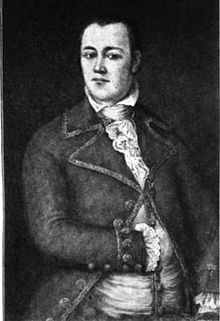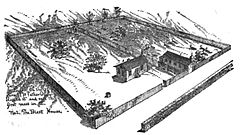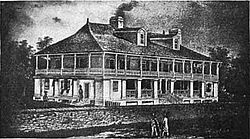- René Auguste Chouteau
-
Auguste Chouteau 
Auguste ChouteauBorn 7 September 1749
New Orleans, LouisianaDied 24 February 1829 (aged 79)
St. Louis, MissouriRene Auguste Chouteau (September 7, 1749 or September 26, 1750 in New Orleans, Louisiana[1] – February 24, 1825 in St. Louis, Missouri[2]), also known as Auguste Chouteau, was founder of St. Louis, Missouri, a successful fur trader and a politician. He and his partner had a monopoly for many years of fur trade with the large Osage tribe on the Missouri River. In addition, he had numerous business interests in St. Louis and was well-connected with the various rulers: French, Spanish and American.
Contents
Early life and education
On September 20, 1748, Marie-Thérèse Bourgeois married René Auguste Chouteau, who had recently immigrated from France to Louisiana.[3] Rene Chouteau was described as an innkeeper, liquor dealer, and pastry chef.[3][4] He was born in the village of L'Hermenault in September 1723, and was nearly ten years older than Bourgeois.[5] Auguste Chouteau was the only child of Marie-Therese and Rene, born in either September 1749 or September 1750.[3][6] The elder Chouteau purportedly abused Marie Therese, resulting in her return to the convent (along with her son, Auguste Chouteau) where she had lived prior to her marriage.[6][7]
By 1758, Marie Therese (known as Madame Chouteau or Widow Chouteau[8]) had met and began living with Pierre de Laclede Liguest (commonly known as Laclede) in a common-law marriage.[9] Kieran Doherty suggests that Laclede informally adopted Auguste Chouteau, providing him with an education in one of the Catholic schools of New Orleans.[10] Regardless of whether formal education was provided Chouteau, it was clear that by his early teens, he had a respect for learning and some form of education (possibly under the direct tutelage of Laclede).[11] By the early 1760s, Chouteau worked as an assistant in obtaining supplies for Laclede's partnership business with Gilbert Antoine de St. Maxent.[10]
 Pierre Laclede, stepfather of Auguste Chouteau and co-founder of St. Louis
Pierre Laclede, stepfather of Auguste Chouteau and co-founder of St. Louis
Settlement of St. Louis
Maxent and Laclede formed a partnership in the early 1760s to build a French trading post on the west bank of the Mississippi River north of the village of Ste. Genevieve, Missouri. They began buying supplies in early 1763, and on July 6, 1763, they obtained the necessary license from the French territorial government to trade with the Native Americans (primarily those living near the Missouri River).[12] Starting in August 1763, Chouteau, Laclede and some 30 other men traveled upriver from New Orleans to Ste. Genevieve with trade goods.[13] By November, the group arrived at Ste. Genevieve, but Laclede found that the village did not have adequate storage for his goods.[14] As it had been settled near the riverbank on bottomland, Laclede "deemed the location insalubrious" for his business.[15] (After repeated flooding, in the 1780s the residents relocated Ste. Genevieve upriver and inland to higher ground.)
The French garrison just across the river at Fort de Chartres agreed to store the goods until the British arrived. (Following the Seven Years War, the French conceded their territory and installations to the victorious British. The fort was to be turned over to the British according to the Treaty of Paris (1763).[16] The commandant of Illinois, Pierre-Joseph Neyon de Villiers, suggested French settlers should relocate from the Illinois Country to New Orleans. (He thought it would be under French control, as he did not know of the Treaty of Fontainebleau (1762) to give control of the area west of the Mississippi to the Spanish).[17] Because of the postwar upheaval, "instead of just establishing a trading post at the mouth of the Missouri, [Laclede] would create an entire community."[18] Laclede believed he could convince many French to move to the west bank of the Mississppi at his new settlement.[19] He planned to store the goods until spring, and then have Chouteau and his team build the trading post at the site they selected in December 1763.[18] As Chouteau wrote, Laclede said, "You will come here as soon as navigation opens, and will cause this place to be cleared, in order to form our settlement after the plan that I shall give you."[20]
In the late winter, Chouteau fitted out a boat and led a party of 30 men across the river, where they landed on February 14, 1764.[21] The next day, February 15, Chouteau directed the men to start clearing and founded the European city of St. Louis.[22] (It was on a site long occupied by indigenous tribes, as demonstrated by the numerous massive earthwork mounds left from the Mississippian culture of the 9th-12th century.)[23]
Laclede was at Fort de Chartres until early April, recruiting French settlers from the east side villages. Because of a large migrating band of Osage, Laclede went to St. Louis to negotiate their departure from the fledgling post.[24][25] Within months, Laclede had built a home for his common-law wife Marie Therese, who traveled to the outpost from New Orleans, arriving in September 1764.[24] Auguste Chouteau lived here until his death.[26] In addition to Auguste, Marie Therese had an additional four children (by Pierre Laclede, but under the surname of Chouteau).[24] Among these four were three girls and a boy, Jean Pierre Chouteau, who later became a partner with Auguste in business and politics.[27]
After Laclede's death in 1778, Chouteau took over the business of trading, adding greatly to the family fortunes.[28] He quickly expanded the business to include agricultural properties, and banking, and owned the first grist mill in St. Louis.[29] Chouteau played a significant role in the growth of other, outlying towns, such as St. Charles, Missouri.[30]
Chouteau also remained on good terms with the Spanish government in St. Louis. In 1780, Chouteau played a small role in the Battle of St. Louis, in which the village was defended against a British-led Native American attack.[31] Chouteau negotiated with the Spanish government for greater defense of the city, and for his efforts was commissioned a captain and later a colonel.[31]
Expansion of trade operations
In the early 1780s, Chouteau played a pivotal role in trade between the village and Native American tribes. His efforts to maintain peace and promote trade led him to establish (along with his brother, Pierre) numerous trading forts along the Missouri River.[32]
His relationship with the Osage Nation became particularly important when, in 1787, the Spanish governor Esteban Miro ordered an end to trade with the Osage and began to prepare for war against them as a result of fighting between Osage and European settlers.[33] Although the government continued its ban on trade with the Osage, Chouteau was able to defuse a conflict between Osage and Spanish-armed settlers through his intervention with Miro.[34] In spite of continuing problems between the Osage and the Spanish government, Chouteau maintained good relations with the tribe.[35] Although the trade ban was lifted in 1791, problems continued among Mississippi tribes and the settlers, including horse theft and threatened attack on an Osage delegation in St. Louis by rival tribes of Sac, Fox, Kickapoo, Mascouten and Winnebago warriors.[36]
In 1793, these problems culminated in an order from the Spanish Governor General Francisco Luis Hector de Carondelet, in which all trade between settlers and tribes was to cease. Hector also ordered a military expedition against the Osage and other tribes.[37] However, Hector was persuaded toward peace by an Osage delegation led by Chouteau to New Orleans in the spring of 1794.[38] To convince Hector of peace, Chouteau promised a military fort built among the Osage at his own expense. In return, Chouteau was given a six-year monopoly on trade along the Osage River.[39]After its construction in 1795, Fort Carondelet, although acting as a military base, was in practice a trading post for the Chouteau family.[40][41] The fort also served as home to Chouteau's nephews, who gained valuable experience as traders.[42] Through contacts at this post, Chouteau also negotiated construction of a second trading post among the Osage, located on the Verdigris River in eastern Kansas from 1795-1797.[43]
However, in 1799, new Spanish Governor General Manuel María de Salcedo began favoring a Spanish businessman instead of the Chouteau fur operation. Fort Carondelet was sold to the Spanish firm, but Chouteau continued trade with the Osage on the Verdigris.[44] Yet the Spanish competition was short-lived, as the Louisiana Territory was transferred first to France in 1800, then the United States in 1803. Late that year, Chouteau provided valuable information to the Lewis and Clark Expedition about the population of the Louisiana territory, along with observations of wildlife and local villages.[45] In early 1804, Lewis and Clark purchased materials from Chouteau's trading house in St. Louis, and on March 9, 1804, Chouteau hosted the new American commander of the Upper Louisiana during the transfer ceremonies for the Louisiana Purchase.[46] For this, Chouteau was rewarded with a return to his monopoly on trade with the tribes by the United States.[47] From 1806 to 1815, Chouteau continued leading family fur trade business, eventually negotiating part of the Treaties of Portage des Sioux in 1815 after the War of 1812. In 1816, Auguste Chouteau retired from his trading businesses.[48] Still active in Indian issues in 1817, Chouteau served as a U.S. Commissioner of Indian Affairs with William Clark in the first U.S. treaty with the Ponca tribe.[49]
Family and death
For more information on the Chouteau family and places named for the Chouteau family, see Chouteau.
Auguste Chouteau never left the St. Louis area (although he had numerous lengthy trading journeys up the Missouri to his outer posts and to trade with the Indians.)[2] He married Marie Therese Cerre on September 21, 1786 at the Basilica of St. Louis, King of France (then a vertical-log church, not the current church on the site).[50] The marriage united members of the two leading St. Louis families; it also appears to have been a happy one.[51] (It is possible that Chouteau had relations with Native American women while on lengthy trading expeditions, but that was considered customary behavior at that time.[51]) They were renowned for their hospitality, which helped strengthen his political position in the city and region.
Chouteau died February 24, 1829.[50] His remains were interred first at the burial grounds near the Basilica of St. Louis, but were reinterred at Calvary Cemetery.[52] After his death, 22 of his 36 slaves were sold at probate, providing $10,838.88 in proceeds, half of which was provided to his wife, with the other half being divided equally among their seven children.[48]
Children of Rene Auguste Chouteau and Marie Therese Cerre:
-
- Auguste Aristide Chouteau (1792-1833), fur trader
- Gabriel Chouteau (1794-1887), served in War of 1812
- Eulalie Choutea (1799-1835), married Rene Paul, first surveyor of St. Louis
- Henry Chouteau (1805-1855), railroad executive, killed in Gasconade Bridge train disaster
- Edward Chouteau (1807-1846), trader
- Louise Chouteau, married Gabriel Paul, brother of Rene and French chevalier
- Emilie Chouteau, married Thomas Floyd, officer in the Black Hawk War
References
- ^ Christian, 30. According to Shirley Christian, Chouteau's parents "baptized a son, whose named was listed only as Rene, on September 9, 1749. There is confusion as to whether this son was Auguste Chouteau or whether the first son died and a second son, Auguste, was born a year later. ... Auguste Chouteau's birth date is listed in family records as September 26, 1750, but no baptismal record has been uncovered."
- ^ a b Beckwith, 8.
- ^ a b c Christian, 30.
- ^ Doherty, 34.
- ^ Foley, 1.
- ^ a b Hoig, 2.
- ^ A child named "Rene" was baptized on that date to Rene Chouteau and Marie Therese. However, the Auguste Chouteau who founded St. Louis, Missouri often was referred to as Rene Auguste, but his birth date was listed in family records as September 26, 1750. Family members in the 19th century used the traditional date (September 26, 1750) for Chouteau's grave marker in Calvary Cemetery. In Rene Chouteau's will, he referred to two living sons as of 1776. Thus, it is possible a second son existed. In that case, it is likely that the second son died after Rene Chouteau left Louisiana. See Foley, 2; Hoig, 2; Christian, 30.
- ^ Foley, 2.
- ^ Hoig, 3.
- ^ a b Doherty, 35.
- ^ Foley, 3.
- ^ Christian, 33.
- ^ Christian, 34.
- ^ Hoig, 5.
- ^ Stevens, 19.
- ^ Christian, 34
- ^ Stevens, 20.
- ^ a b Christian, 36.
- ^ Christian, 38.
- ^ Chouteau, 4.
- ^ Christian, 37. Some dispute exists as to whether the party landed on February 14 or March 14, based on a discrepancy in Chouteau's narrative. Most historians ascribe Chouteau's date as an error.
- ^ Christian, 36-7.
- ^ Stevens, 23.
- ^ a b c Hoig, 7.
- ^ Christian, 41
- ^ Stevens, 57.
- ^ Hoig, 12.
- ^ Hoig, 13.
- ^ Hoig, 14.
- ^ Hoig, 17.
- ^ a b Hoig, 15.
- ^ Hoig, 69.
- ^ Hoig, 19.
- ^ Hoig, 19.
- ^ Hoig, 19.
- ^ Hoig, 19.
- ^ Hoig, 19.
- ^ Hoig, 19.
- ^ Hoig, 20.
- ^ Hoig, 21-23.
- ^ Fort Carondelet, although no longer extant, stood on Halley's Bluff in Vernon County, Missouri, a site now occupied by the Church of Christ at Halley's Bluff.
- ^ Hoig, 21.
- ^ Hoig, 24.
- ^ Hoig, 25.
- ^ Hoig, 26.
- ^ Hoig, 26.
- ^ Hoig, 26.
- ^ a b National Park Service
- ^ 1817 U.S.-Ponca treaty
- ^ a b Beckwith, 9.
- ^ a b Foley, 45.
- ^ FindaGrave.com
Bibliography
- Beckwith, Paul Edmond. Creoles of St. Louis. St. Louis: Nixon-Jones, 1893.
- Chouteau, Auguste. A Fragment of Col. Auguste Chouteau's Narrative of the Settlement of St. Louis. St. Louis: Knapp and Co., 1858.
- Christian, Shirley. Before Lewis and Clark: The Story of the Chouteaus, the French Dynasty That Ruled America's Frontier. New York: Farrar, Straus and Giroux, 2004.
- Doherty, Kieran. Ranchers, Homesteaders and Traders: Frontiersmen of the South-Central States.
- Foley, William E. The First Chouteaus: River Barons of St. Louis. Urbana: University of Illinois Press, 1983.
- Hoig, Stan. The Chouteaus, First Family of the Fur Trade. Albuquerque: University of New Mexico Press, 2008.
- Stevens, Walter Barlow. St. Louis: The Fourth City, 1764-1911. St. Louis: S.J. Clarke Co., 1911.
External links
- Jay Gitlin, "Constructing the House of Chouteau: Saint Louis", Common-Place, Vol. 3, No. 4
- Auguste Chouteau Collection, Mercantile Library, University of Missouri at St. Louis
Categories:- 1749 births
- 1829 deaths
- People from New Orleans, Louisiana
- Pre-state history of Missouri
- City founders
-
Wikimedia Foundation. 2010.


